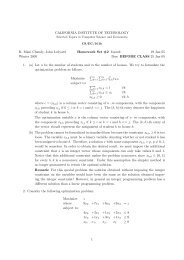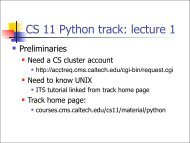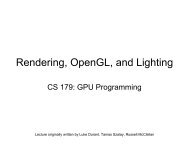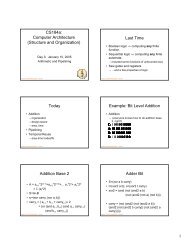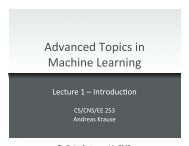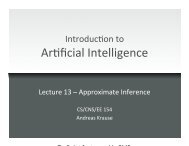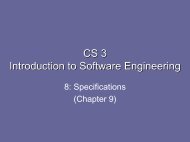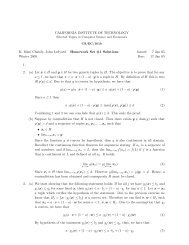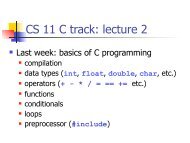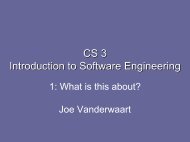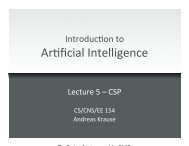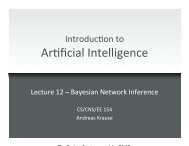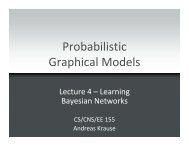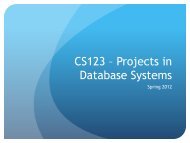Introduction
Introduction
Introduction
You also want an ePaper? Increase the reach of your titles
YUMPU automatically turns print PDFs into web optimized ePapers that Google loves.
<strong>Introduction</strong> to<br />
Artificial Intelligence<br />
Lecture 1 – <strong>Introduction</strong><br />
CS/CNS/EE 154<br />
Andreas Krause
What is AI?<br />
“The science and engineering of<br />
making intelligent machines”<br />
(McCarthy, ’56)<br />
What does “intelligence” mean??<br />
3
The Turing test<br />
Turing (’50): Computing Machinery and Intelligence<br />
Predicted that by 2000, machine has 30% of fooling a<br />
lay person for 5 minutes<br />
Currently, human-level AI not within reach<br />
4
What if we had intelligent machines?<br />
Will machines surpass human intelligence?<br />
Should intelligent machines have rights?<br />
What will we do with superintelligent machines?<br />
What will they do with us?<br />
…<br />
5
AI today<br />
6
Autonomous driving<br />
Caltech’s Alice<br />
DARPA Grand Challenges:<br />
2005: drive 150 mile in the Mojave desert<br />
2007: drive 60 mile in traffic in urban environment<br />
7
Humanoid robotics<br />
Honda ASIMO<br />
TOSY TOPIO<br />
8
Autonomous robotic exploration<br />
??<br />
Limited time for measurements<br />
Limited capacity for rock samples<br />
Need optimized<br />
information gathering!<br />
9
A robot scientist<br />
[King et al, Nature ’04, Science ‘09]<br />
10
Games<br />
IBM’s Deep Blue wins 6 game match against<br />
Garry Kasparov (’97)<br />
11
Games<br />
Go: 2008: MoGo beats Pro (8P) in 9-stone game<br />
Poker: Next big frontier for AI in games<br />
12
Computer games<br />
13
NLP / Dialog management<br />
[Bohus et al.]<br />
14
Reading the web<br />
[Carlson et al., AAAI 2010]<br />
Never-Ending Language Learner<br />
After 67 days, built ontology of 242,453 facts<br />
Estimated precision of 73%<br />
15
Scene understanding<br />
[Li et al., CVPR 2009]<br />
16
Topics covered<br />
Agents and environments<br />
Search<br />
Logic<br />
Games<br />
Uncertainty<br />
Planning<br />
Learning<br />
Advanced topics<br />
Applications<br />
17
Overview<br />
Instructor:<br />
Andreas Krause (krausea@caltech.edu) and<br />
Teaching assistants:<br />
Pete Trautman (trautman@cds.caltech.edu)<br />
Xiaodi Hou (xiaodi.hou@gmail.com)<br />
Noah Jakimo (njakimo@caltech.edu)<br />
Administrative assistant:<br />
Lisa Knox (lisa987@cs.caltech.edu)<br />
18
Textbook:<br />
Course material<br />
S. Russell, P. Norvig: Artificial Intelligence,<br />
A Modern Approach (3 rd edition)<br />
Additional reading on course<br />
webpage:http://www.cs.caltech.edu/courses/cs154/<br />
19
Background & Prequisites<br />
Formal requirements:<br />
Basic knowledge in probability and statistics (Ma 2b or<br />
equivalent)<br />
Algorithms (CS 1 or equivalent)<br />
Helpful: basic knowledge in complexity (e.g., CS 38)<br />
20
Grading based on<br />
Coursework<br />
3 homework assignments (50%)<br />
Challenge project (30%)<br />
Final exam (20%)<br />
3 late days, for homeworks only<br />
Discussing assignments allowed, but everybody must<br />
turn in their own solutions<br />
Exam will be take home open textbook. No other<br />
material or collaboration allowed for exam.<br />
Start early! ☺<br />
21
Challenge project<br />
“Get your hands dirty” with the course material<br />
More details soon<br />
Groups of 2-3 students<br />
Can opt to do independent project<br />
(with instructors permission)<br />
22
Agents and environments<br />
Agents: Alice, Poker player, Robo receptionist, …<br />
Agent maps sequence of percepts to action<br />
Implemented as algorithm running on physical architecture<br />
Environment maps sequence of actions to percept<br />
24
Example: Vacuum cleaning robot<br />
Percepts P = {[A,Clean], [A,Dirty], [B,Clean], [B,Dirty]}<br />
Actions A = {Left, Right, Suck, NoOp}<br />
Agent function:<br />
Example:<br />
25
Modeling the environment<br />
Set of states S (not necessarily finite)<br />
State transitions depend on current state and actions<br />
(can be stochastic or nondeterministic)<br />
26
Rationality: Performance evaluation<br />
Fixed performance measure<br />
evaluates environment seq.<br />
For example:<br />
One point for each clean square after 10 rounds?<br />
Time it takes until all squares clean?<br />
One point per clean square per round, minus one point per move<br />
Goal: find agent function (program) to maximize<br />
performance<br />
27
PEAS: Specifying tasks<br />
To design a rational agent, we need to specify<br />
Performance measure, Environment, Actuators, Sensors.<br />
Example: Chess player<br />
Performance measure: 2 points/win, 1 points/draw, 0<br />
for loss<br />
Environment:<br />
Actuators:<br />
Chess board, pieces,<br />
rules, move history<br />
move pieces, resign<br />
Sensors: observe board position<br />
28
PEAS: Specifying tasks<br />
Example: Autonomous taxi<br />
Performance measure: safety, fare, fines, satisfaction, …<br />
Environment:<br />
Actuators:<br />
road network, traffic rules, other<br />
cars, lights, pedestrians, …<br />
steer, gas, brake, pick up, …<br />
Sensors: cameras, LIDAR, weight sensor, ..<br />
29
Environment types<br />
Sudoku Poker Spam Filter Taxi<br />
Observable?<br />
Deterministic?<br />
Episodic?<br />
Static?<br />
Discrete?<br />
Single-agent?<br />
30
Agent types<br />
In principle, could specify action for any possible<br />
percept sequence<br />
Intractable<br />
Different types of agents<br />
Simplex reflex agent<br />
Reflex agents with state<br />
Goal based agents<br />
Utility based agents<br />
31
Simple reflex agent<br />
Action only function of last percept<br />
32
Example<br />
Percept<br />
[A,dirty]<br />
[B,dirty]<br />
[A,clean]<br />
[B,clean]<br />
Action<br />
Suck<br />
Suck<br />
Right<br />
Left<br />
Will never stop (noop), since we can’t remember state<br />
This is a fundamental problem of simple reflex agents in<br />
partially observable environments!<br />
33
Reflex agent with state<br />
Action function of percept and internal state<br />
34
Example<br />
State vars: cleanA = cleanB = false<br />
Percept cleanA cleanB Action State change<br />
[X,dirty] ? ? Suck cleanX = true<br />
[A,clean] ? true NoOp<br />
[A,clean] ? false Right<br />
[B,clean] true ? NoOp<br />
[B,clean] false ? Left<br />
? means “don’t care”<br />
35
Goal-based agents<br />
36
Utility-based agents<br />
37
What you need to know<br />
Agents interact with the environment using sensors<br />
and actuators<br />
Performance measure evaluates environment state<br />
sequence<br />
A perfectly rational agent maximizes (expected)<br />
performance<br />
PEAS descriptions define task environments<br />
Environments categorized along different dimensions<br />
Observable? Deterministic? …<br />
Basic agent architectures<br />
Simple reflex, reflex with state, goal-based, utility-based, …<br />
38



